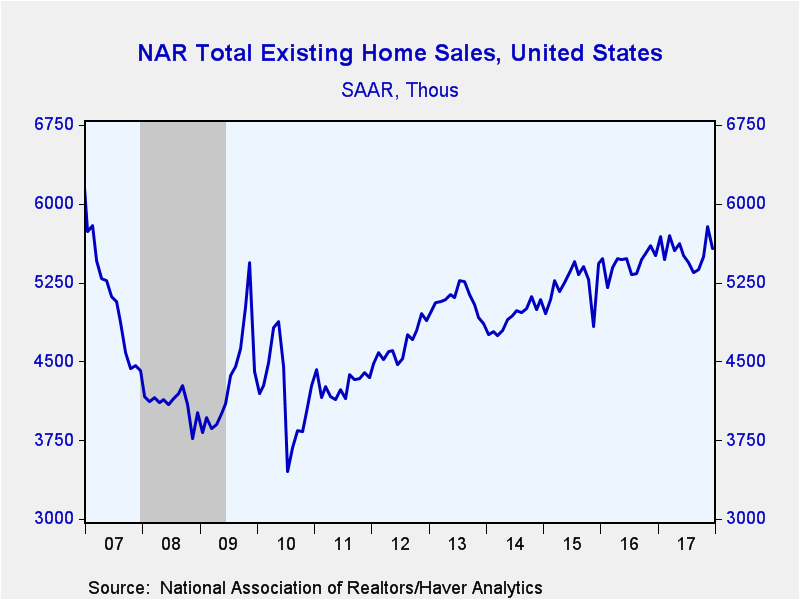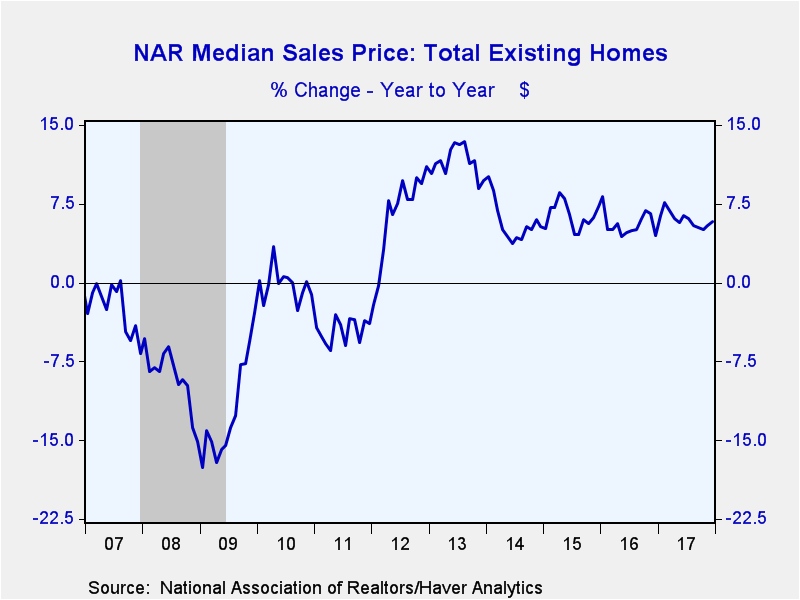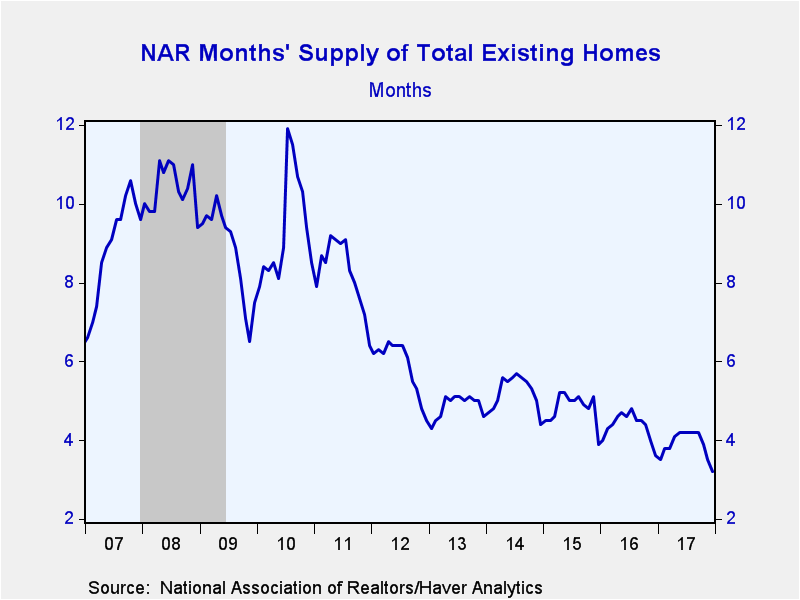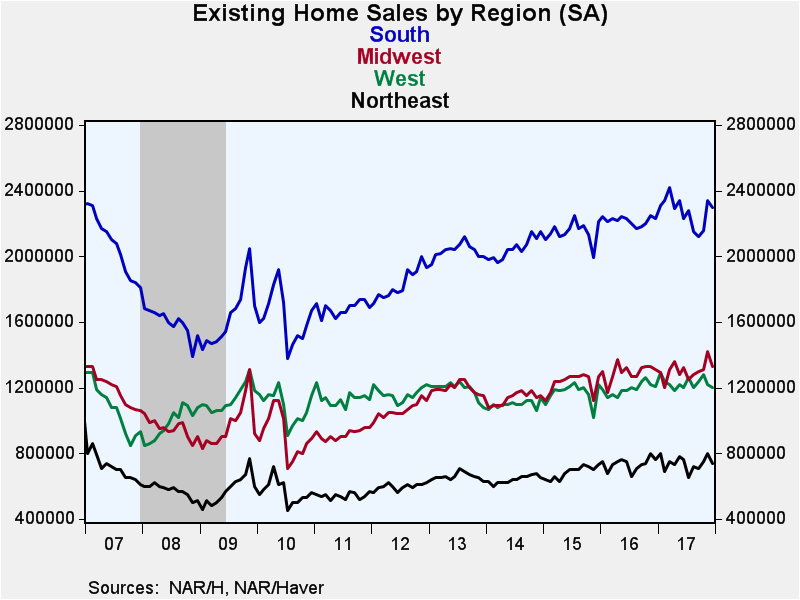 Global| Jan 24 2018
Global| Jan 24 2018U.S. Existing Home Sales & Prices Rise in 2017
by:Tom Moeller
|in:Economy in Brief
Summary
The National Association of Realtors reported that sales of existing homes in 2017 improved 2.0% to 5.547 million units. It was the highest level of sales since 2006, despite a December decline of 3.6% (+1.1% y/y) to 5.570 million [...]
The National Association of Realtors reported that sales of existing homes in 2017 improved 2.0% to 5.547 million units. It was the highest level of sales since 2006, despite a December decline of 3.6% (+1.1% y/y) to 5.570 million (AR) from 5.780 million in November. Expectations were for 5.700 million December sales in the Action Economics Forecast Survey.
The median price of all existing homes sold rose 5.8% y/y during December to $246,800. The rate of increase has been fairly stable for several years. During all of 2017, the median price averaged $245,975, up 6.0% y/y.
Sales of existing single-family homes declined 2.6% during December (+1.0% y/y) to 4.960 million units. Sales of co-ops and condos were off 11.6% (+1.7% y/y) to 610,000.
The number of homes on the market declined by 10.3% last year following a 6.3% decline in 2016. The supply of homes for sale fell to 3.2 months by the end of the year. That compared to a 10.4 months during all of 2008.
By region, December total existing home sales in the Midwest fell 6.3% (+1.5% y/y) to 1.330 million units. In the South, sales eased 1.7% (+3.1% y/y) to 2.330 million units. Home sales in the Northeast were off 7.5% (-2.6% y/y) to 740,000 units. Sales in the West declined 1.6% (-0.8% y/y) to 1.200 million units.
The data on existing home sales, prices and affordability are compiled by the National Association of Realtors and can be found in Haver's USECON database. The regional price, affordability and inventory data are available in the REALTOR database. The expectations figure is from the Action Economics Forecast Survey, reported in the AS1REPNA database.
| Existing Home Sales (SAAR, 000s) | Dec | Nov | Oct | Y/Y % | 2017 | 2016 | 2015 |
|---|---|---|---|---|---|---|---|
| Total | 5,570 | 5,780 | 5,500 | 1.1 | 5,547 | 5,440 | 5,234 |
| Northeast | 740 | 800 | 750 | -2.6 | 740 | 735 | 685 |
| Midwest | 1,330 | 1,420 | 1,310 | 1.5 | 1,304 | 1,296 | 1,231 |
| South | 2,300 | 2,340 | 2,160 | 3.1 | 2,273 | 2,217 | 2,148 |
| West | 1,200 | 1,220 | 1,280 | -0.8 | 1,229 | 1,193 | 1,170 |
| Single-Family | 4,960 | 5,090 | 4,870 | 1.0 | 4,920 | 4,828 | 4,624 |
| Median Price Total ($, NSA) | 246,800 | 247,200 | 246,000 | 5.8 | 245,975 | 232,067 | 219,867 |
Tom Moeller
AuthorMore in Author Profile »Prior to joining Haver Analytics in 2000, Mr. Moeller worked as the Economist at Chancellor Capital Management from 1985 to 1999. There, he developed comprehensive economic forecasts and interpreted economic data for equity and fixed income portfolio managers. Also at Chancellor, Mr. Moeller worked as an equity analyst and was responsible for researching and rating companies in the economically sensitive automobile and housing industries for investment in Chancellor’s equity portfolio. Prior to joining Chancellor, Mr. Moeller was an Economist at Citibank from 1979 to 1984. He also analyzed pricing behavior in the metals industry for the Council on Wage and Price Stability in Washington, D.C. In 1999, Mr. Moeller received the award for most accurate forecast from the Forecasters' Club of New York. From 1990 to 1992 he was President of the New York Association for Business Economists. Mr. Moeller earned an M.B.A. in Finance from Fordham University, where he graduated in 1987. He holds a Bachelor of Arts in Economics from George Washington University.










